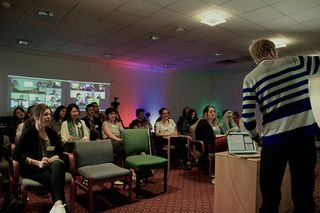8 tips to turbocharge your creative career
Fresh from Collabology, Fred Deakin explains how new designers can tool-up and tackle the rapidly evolving industry.
If you could give the next generation of creative trailblazers one skill to carry through their future careers, what would it be?
In June, thousands of design students will graduate into the real world; a fast-paced, cross-disciplinary environment characterised by two certainties: rapid innovation and a volatile job market.
So, in an industry where software skills date faster than fashion and design thinking is king, what one skill would you offer a young creative to turbo-charge their career?
For creative veteran Fred Deakin, it would be collaboration. In April, he led an intensive two-week workshop, Collabology, to help a selection of students better understand their skills, grow their creative confidence and learn to collaborate under pressure.
Building on a successful pilot at Mother London in 2014, Collabology brought 20 UAL students together, from a range of disciplines, to conceive and deliver a cross-media project aimed at creating positive change in society.
A further 24 students from Falmouth University and Manchester School of Art also participated in the initiative, linking remotely to the London hub – where they could participate in lectures and crit sessions – using cutting-edge collaborative digital tools, such as Fuze.

Funded through UAL's University Chairs project and Creative Skillset, the experimental education initiative seeks to revolutionise how design is taught and better prepare participants for industry.
We turned up to on day eight to see how the students were getting on – and were impressed not only by the range and depth of ideas, but with the professionalism of the students as they presented their projects.
So why is collaboration so important for the next generation of creative graduates? Here, Deakin explains what's wrong with design education in UK – and what everyone can learn from last week's workshop...
01. Collaboration skills can bridge the gulf between academia and industry
Above: WeWee is a public toilet-finding app for mobile and apple watch by Sean Murphy and Chin Tan of UAL.
Fred Deakin: Traditionally education in the UK has been about the individual. It's about assessing people as individuals, who are studying individual subjects and paying individual fees for an individual mark.
That doesn't necessarily serve graduates very well when they go into the workplace, especially in a post-digital age. The complexity of projects, the timelines and the pace of innovation means you can only really achieve excellence with a cross-disciplinary team – with more than one set of individual skills.
The academic ivory tower to dive into experimental research – that's really important too. But collaboration is what's missing, so with Collabology we pulled students from across a range of disciplines and put them together in a pop-up design studio.
02. Entrepreneurship is a future-proof skill
Above: Physicode, by Falmouth University's Kassy Bull and Charlie Cattel-Killick, teaches children the logic of coding and technology through physical play.
One of the other aims of Collobology is entrepreneurialism. I see students going out there, begging for unpaid internships, and they're very much on the back foot. They're an exploitable resource by less than scrupulous employers.
If you can give students a taste of start-up culture, of entrepreneurship, of bootstrapping – a tangible experience of conceiving a project that they believe in, and coming together with their peers to deliver it – then they get it.
Collabology is an experiential workshop. That's its big point of difference. It's all about learning by doing, which is the classic art school model – it's just it's always been learning by doing on your own.
03. Young creatives are far more powerful than they think they are
Above: Chermaine Koo David Baker, Jodie Newsum, Qian Qiu, Ricco Martini, Tommaso Cesaro of UAL created ReCoin, a digital currency to encourage good recycling behaviour.
I want students to release that if they come together with their peers, they can tackle the problems they see around them that the government and business are failing to deal with.
They can generate careers from their vision and their talent together. They don't need anyone else to give them a hand. They're going to have to sort out the problems of the next decades and may as well start now.
With Collobology, I also want them to learn that they can set up as a commercial operation as well, and to learn the professionalism required to conceive and present a project. I'm trying to give career skills.
Next page: 5 more of Fred Deakin's career tips

Thank you for reading 5 articles this month* Join now for unlimited access
Enjoy your first month for just £1 / $1 / €1
*Read 5 free articles per month without a subscription

Join now for unlimited access
Try first month for just £1 / $1 / €1
Get the Creative Bloq Newsletter
Daily design news, reviews, how-tos and more, as picked by the editors.
The Creative Bloq team is made up of a group of design fans, and has changed and evolved since Creative Bloq began back in 2012. The current website team consists of eight full-time members of staff: Editor Georgia Coggan, Deputy Editor Rosie Hilder, Ecommerce Editor Beren Neale, Senior News Editor Daniel Piper, Editor, Digital Art and 3D Ian Dean, Tech Reviews Editor Erlingur Einarsson and Ecommerce Writer Beth Nicholls and Staff Writer Natalie Fear, as well as a roster of freelancers from around the world. The 3D World and ImagineFX magazine teams also pitch in, ensuring that content from 3D World and ImagineFX is represented on Creative Bloq.
